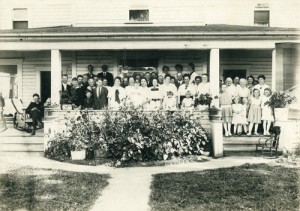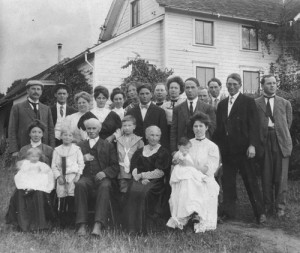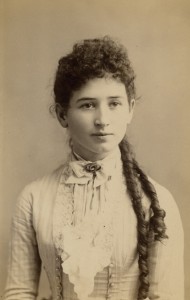As Oregon celebrates its Sesquicentennial, Our Town Life salutes the families and institutions that have a long history in the Silverton, Mt. Angel, Molalla and Scotts Mills region. This is the second segment in the year-long series.
Tom Ewing and his wife, Virginia, live west of Mt. Angel on a farm established by Tom’s ancestors early in Oregon’s history. They treasure the traditions of farm and family that have been passed along for more than 150 years.
Ewing has compiled a book of stories of those who traversed the Oregon Trail. These pioneers include his great-great grandparents, Hanson and Lavina Stevens.
Among his books are a journal written by his adventurous great-grandfather, Alexander Esson, and volumes that record more than a century of family reunions.
 “In 1891 the children of Hanson and Lavina started holding a family reunion – a potluck picnic. We have met ever since. The family early on, maybe at the first, decided to make this an annual event, and so purchased a leather-bound journal to record each reunion. It covers the 100 years from 1891 to 1990. We keep it in a safe deposit vault. We purchased a new leather-bound journal for the second century. In 1990 we had our 100th anniversary. We held it on my farm, because that’s the only property still owned by the original family. National Geographic did a piece on us for its magazine. We had about 300 people.”
“In 1891 the children of Hanson and Lavina started holding a family reunion – a potluck picnic. We have met ever since. The family early on, maybe at the first, decided to make this an annual event, and so purchased a leather-bound journal to record each reunion. It covers the 100 years from 1891 to 1990. We keep it in a safe deposit vault. We purchased a new leather-bound journal for the second century. In 1990 we had our 100th anniversary. We held it on my farm, because that’s the only property still owned by the original family. National Geographic did a piece on us for its magazine. We had about 300 people.”
The family’s story starts in 1852 with an arduous journey from Iowa by Ewing’s great-great-grandfather, Hanson Stevens, his wife, Lavina, their six daughters and one son.
“Of all the years of the Oregon Trail, 1852 was the most difficult because of cholera and congestion,” Ewing said. “It was a terrible, terrible trip.”
In his research, Ewing learned more people crossed the plains that year than any other – they were seeking 320 acres of free land offered through the Donation Land Act to every husband and wife settling in the Pacific Northwest.
The flood of emigrants with their wagons and livestock stirred up choking dust and consumed ambient food and firewood, which meant the later travelers had to search great distances for sustenance – or starve. Also, drinking water was contaminated and cholera was rampant that year.
The Stevenses made it to Oregon Territory in late October. But their trials weren’t over. At The Dalles, Lavina and the girls took a scow paddled by Indians on a perilous trip down the Columbia River. Hanson and his son, Isaac, drove their livestock through the mountains. The family reunited, reassembled the wagon and portaged around Celilo Falls. Hanson and Isaac again disassembled the wagon, lowered it and their belongings by rope about 100 feet down a bank to a raft or steamboat. The mother and six daughters traveled on the boat while the father and son again drove the animals.
At the Sandy River, the family reunited, reassembled the wagon and traveled to their Donation Land claim at the corner of present-day Saratoga and North Howell Roads outside Silverton.
They got a tough start – with only $5 left when they arrived there was no money for cattle feed. It was an exceptionally bad winter and the cattle did not survive.
Seven years later, Lavina died. At her grave in Bethany Cemetery, the family planted a rose they had brought from Iowa. The rose is still there.
Hanson remarried, but his new wife was “spiteful,” said Ewing. “She took a real dislike to the girls.”
One of them, Christina, was about 14 when she left home to work at the Wesley Shannon farm, near where Shannon Road and Silverton Road meet. Later a Scotsman named Alexander Esson came to work there too. In 1859, he had sailed south from New York, traveled by train through the jungle across the Isthmus of Panama and boarded a northbound ship to seek his fortune in California. But finding no gold, he traveled by horseback to Oregon, where he found work with the Shannons.
 Despite their age difference – Alexander was 39, Christina 18 – the Shannons thought the self-educated man was quite a catch and encouraged her to marry him. They married Christmas Eve 1862.
Despite their age difference – Alexander was 39, Christina 18 – the Shannons thought the self-educated man was quite a catch and encouraged her to marry him. They married Christmas Eve 1862.
Esson wanted a farm of his own, and found one that reminded him of Scotland about a mile west of Mt. Angel – the farm where the Ewings live today. In 1864, Alexander and Christina Esson and their baby, Inez, moved to a log cabin on the 300-acre property.
Esson later built a frame house for the family that included 11 more children. They raised grain, livestock and felled timber.
“I interviewed the youngest child when she was in her 90s,” Ewing said. “She made the point that they made everything themselves – soap, preserved food and did everything they needed by themselves.”
In the summer of 1891, one of the younger daughters, Ida, went to the Shannon farm to visit her sister, Inez, who had married the Shannons’ nephew who had inherited their farm. During her visit, an epidemic came to the area. Benedictine Sisters of Mt. Angel heard the family was ill and came to help. Ida died and a couple of days later so did Inez.
 Esson buried Ida on the family farm and planted a hedge of cedar trees to outline the family cemetery. “That hedge is now a towering perimeter of cedar trees,” Ewing said, adding that it is a special place for the family. “Alexander and Christina are buried there, my grandparents, my parents, my sister and some other members of the family.”
Esson buried Ida on the family farm and planted a hedge of cedar trees to outline the family cemetery. “That hedge is now a towering perimeter of cedar trees,” Ewing said, adding that it is a special place for the family. “Alexander and Christina are buried there, my grandparents, my parents, my sister and some other members of the family.”
Esson’s other daughter who died of the disease, Inez, left three children. The boy stayed with his father and the two girls went to the Benedictine Monastery to be cared for by the Sisters.
“That began a lasting relationship between the Essons and the Sisters,” Ewing said. “Later, when the Benedictine fathers were trying to raise money to purchase Abbey Hill in Mt. Angel, my great-grandfather contributed generously.” It’s been a family joke that as a Protestant, Esson just didn’t understand the difference between the Sisters and the Brothers.
In the 1890s, Esson had saved enough money to send the older children to university, but by the time their youngest son, Leroy, was to go to college, there was no more money for him to realize his dream of becoming a veterinarian. Leroy Esson stayed on the farm, and after both parents died, he inherited half of it. His siblings got the other half, with the provision that he could buy their interests.
In 1922, the frame house caught fire. Leroy and his wife, Lola, rescued their two children, Alexander (“Zan”) and Evanelle, but the house was destroyed. They built a log house as a temporary home.
Ewing said Leroy and Lola’s marriage “was not made in heaven.” “It took them 10 years to agree on a design (for a new house) because they couldn’t agree on a thing.”
By then it was the Depression; money was extremely scarce. But in 1933 Lola came into an inheritance, allowing them to build the house. Construction was almost finished when their 16-year-old son, Zan, suffered appendicitis. Before he left for the hospital, he was fed his favorite breakfast. On the surgical table and under anesthesia, Zan regurgitated, asphyxiated and died. He, too, is buried on the farm.
Lola died in 1948 and Leroy in 1959. Their daughter, Evanelle, and her husband, Tom Ewing Sr., moved to the farm in 1960 with their children, Tom, Zan and Christina. Tom Jr. graduated from high school in Mt. Angel and became a professor of Chinese, Russian and Mongolian studies in England.
Due to health issues, Tom Sr. and his wife moved away and the farm was rented out. After awhile, Tom Jr. and his wife, Virginia, decided they should return. They realized, “If you don’t, family farms get lost.”
“I probably would have been voted least likely to return to the farm,” Ewing said. “I’m not mechanical and not a farmer. The profession is just too difficult.”
He jokes that “there were not a lot of jobs teaching Chinese, Russian and Mandarin in this area,” so he went to law school. The day after his bar exam, the couple and their son, Zan, moved to the farm. They had two more children, Ross and Nathan.
For the past nine years, Ewing was chief administrative law judge for the State of Oregon. He said he “resigned about three months ago – but I’m not the retiring type.”
His plans for the near future include the family reunion – this year will be the 119th.
